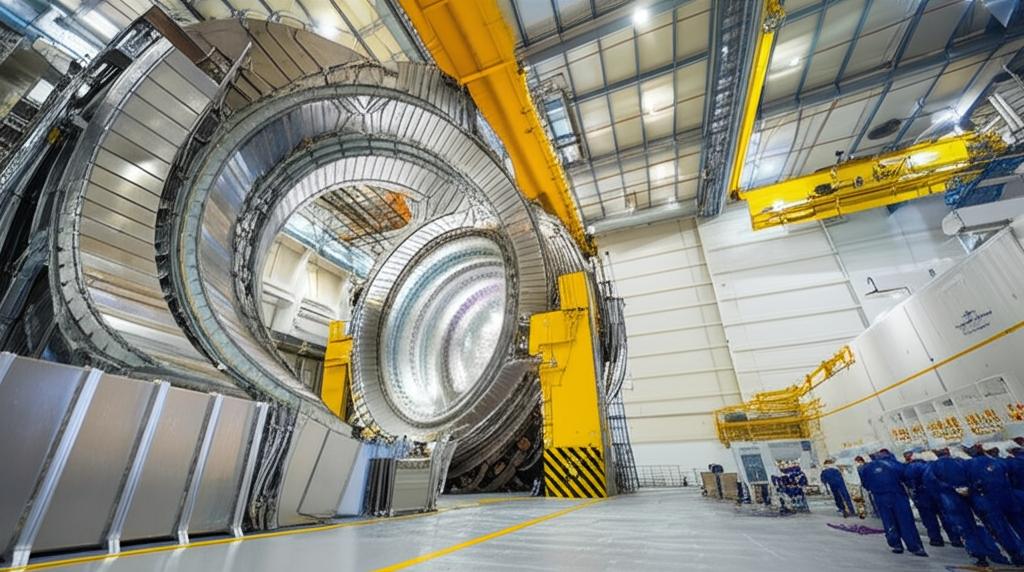The immense challenge of replicating the Sun's energy on Earth requires unprecedented engineering solutions, particularly within the heart of the ITER Tokamak: its massive superconducting magnet system. Recent progress highlights significant engineering leaps in designing, manufacturing, and preparing these critical components for assembly.
The Heart of ITER: A System of Superconducting GiantsITER's magnet system is the largest and most complex of its kind ever constructed, weighing around 10,000 tonnes and storing a staggering 51 Gigajoules of magnetic energy. Its primary role is to create an invisible magnetic cage to confine, shape, and control the 150-million-degree Celsius plasma where fusion reactions will occur. This system comprises several key types of magnets:
- Central Solenoid (CS): Often called the "heart" of ITER, this powerful magnet induces the electric current within the plasma, initiating and sustaining the fusion process.
- Toroidal Field (TF) Coils: Eighteen massive D-shaped coils arranged around the doughnut-shaped vacuum vessel, responsible for confining the plasma particles within the chamber.
- Poloidal Field (PF) Coils: Six ring-shaped coils positioned outside the TF coil structure, controlling the plasma's shape and stability.
- Correction Coils (CC): Smaller coils inserted between the main magnets to fine-tune the magnetic field and compensate for tiny imperfections.
To achieve the required magnetic field strength efficiently, these magnets utilize superconducting materials – primarily Niobium-tin (Nb3Sn) for the TF coils and CS, and Niobium-titanium (NbTi) for the PF coils. These materials only become superconducting when cooled to extremely low temperatures (around 4 Kelvin or -269°C) using a sophisticated cryogenic system circulating supercritical helium.
Recent Engineering Advances and MilestonesA major recent advancement is the completion of all major components for the powerful pulsed superconducting magnet system. This includes the final, sixth module of the Central Solenoid, built and tested in the United States and completed around April 2025.
- Central Solenoid Completion: The CS itself is an engineering marvel. Standing 18 meters (59 feet) tall when fully assembled from its six modules (each weighing around 110-121 tonnes), it's the most powerful of ITER's magnets, capable of generating magnetic forces strong enough to lift an aircraft carrier. The successful completion of all six modules represents a culmination of over a decade of design and manufacturing effort.
- CS Support Structure: Equally crucial is the complex support structure, or "exoskeleton," designed and delivered by the US. Comprising over 9,000 individual parts manufactured by eight different suppliers, this structure is engineered to withstand the immense electromagnetic forces generated during operation, holding the six CS modules precisely in place. Specialized fastening technologies, like Superbolts®, were employed to ensure structural integrity under extreme stress.
- TF Coil Production: The production of the 18 TF coils (10 by Europe, 8 plus a spare by Japan) represents a massive leap in manufacturing capability. Each coil is roughly 17 meters tall, 9 meters wide, and weighs about 320-360 tonnes. They are the largest Nb3Sn magnets ever produced, requiring a significant global ramp-up in the production capacity of the advanced Niobium-tin superconducting strands (over 100,000 km required for ITER overall).
- PF Coil Delivery and Assembly Initiation: Europe, Russia, and China have contributed the large PF ring coils (ranging up to 25 meters in diameter). The insertion of the first PF coil (PF6, manufactured in China) into the Tokamak pit in 2021 marked the official beginning of the magnet system assembly.
- Materials and Manufacturing Scale: The project spurred significant advancements in the industrial-scale production of high-performance superconducting wires. Nine suppliers globally produced the 500 tonnes of Nb3Sn strand needed, pushing manufacturing technology forward. The cable-in-conduit conductor design, where superconducting strands are bundled with copper and enclosed in a steel jacket, is a key technology employed.
Building ITER's magnets involved overcoming numerous technical hurdles:
- Scale and Precision: Manufacturing components the size of multi-story buildings with sub-millimeter precision.
- Extreme Forces: Designing structures to withstand forces equivalent to thousands of tons.
- Material Science: Developing and reliably producing vast quantities of advanced superconducting materials.
- Cryogenics: Designing and implementing one of the world's largest and most complex cryogenic cooling systems.
- International Integration: Coordinating design, manufacturing, and delivery across dozens of countries and hundreds of suppliers.
As of early 2025, assembly is progressing steadily. Four CS modules were installed by January 2025, with the fifth module transported to the site in April 2025. The final module is expected to be installed later in the year. The successful insertion of the first massive vacuum vessel sector into the Tokamak pit in April 2025, ahead of schedule, further demonstrates momentum.
The completion of all major superconducting magnet components is a testament to engineering innovation and sustained international collaboration. These advancements are paving the way for the assembly of the ITER machine and the crucial next steps in demonstrating the potential of fusion as a clean, safe, and virtually limitless energy source.

